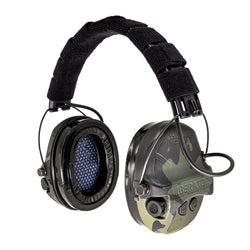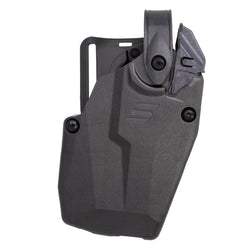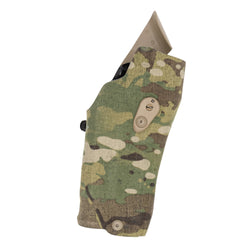I’ve dived headfirst into the world of snub-nose revolvers lately. To me, the revolver is an excellent pocket pistol and a competent close-range defensive weapon. I’ve become a big fan of two specific revolvers: the S&W 940 and the S&W 432 UC.
The S&W 432 UC made a big splash. It returned a moderately powered .32 caliber chambering to the world of modern revolvers with the .32 H&R Magnum. Two revolver experts, Darryl Bolke and Bryan Eastridge, were consulted in its design by Lipsey’s and S&W. The 432 UC is a Lipsey’s distributor exclusive.

The S&W 940 is also a blast from the past. The 940 series was produced in the 1990s but was discontinued until only recently. The S&W 940 is a 9mm revolver built on the traditional J-frame. It shares some features with the UC series but is its own unique revolver that’s a Davidson’s exclusive.
432 UC vs 940: How They Are Different
I enjoy both revolvers immensely, but is one better than the other? That’s tough to say, but we can break down their pros and cons in depth and hopefully guide you to the best option for your needs.
Caliber
The biggest difference between the two guns is caliber. The 432 UC fires the .32 H&R Magnum, a revolver round designed for short-barreled, concealed carry revolvers. The S&W 940 fires 9mm, which is traditionally a semi-automatic pistol cartridge.
Both rounds meet the FBI’s standard for penetration. Both can reach the vitals and stop an attacker. However, there are some sharp differences between them.

The .32 H&R Magnum also allows you to fire the more affordable .32 S&W Long, as well as the somewhat rare .32 S&W. The .32 H&R Magnum has considerably less recoil than the 9mm, which makes it easier to shoot quickly. The smaller-diameter rounds allow you to carry six rounds instead of the traditional five.
The 9mm is a prevalent option, available in a wide variety of loadings. This makes 9mm the much, much cheaper and easier-to-find cartridge for training and concealed carry. It also likely aligns with semi-automatic pistols you already own.
The 9mm round has more recoil, which makes follow-up shots slower.

If you like numbers, my fastest Bill Drill is 2.07 seconds with the .32 H&R Magnum. My fastest with the 940 is 2.44 seconds. Both drills were fired from a strong-side pocket draw with the same Safariland Model 25 holster.
The 940 and the 9mm rounds require you to use moon clips to provide sufficient extraction and ejection. Moon clips can act as speed loaders, but tend to be made from thin metal that can easily bend or break during loading or unloading.
Grips and Concealment
Grips play a significant role in controlling the gun and shooting it accurately. They also play a role in concealment, which is crucial for a pocket gun. The 432 UC and the 940 both take different routes.
The 432 UC uses High Horn grips from VZ. These are round, somewhat wide grips that offer a full grip on the gun and ride high on the frame. I can get a great grip on the gun, and this leads to better control.

The downside is that the extra size can be a concealment issue for some people. It fills your pocket a bit more than the grips on the 940.
The grips on the 940 are G10 and highly textured. They provide a nice, aggressive grip but are quite small. Combine the small grips with the extra recoil of the 940, and the gun becomes a bit tougher to shoot.
Sights
Both guns come with a rear dovetailed sight. I prefer this type of dovetailed sight, mostly because I’m coming from automatics to revolvers and find these sights easier to transition to.

The front sight is a big XS sight and is incredibly easy to see. It glows for night sight usage and is quite nice overall. Both guns have identical sights, and I enjoy both. I find the presence of a rear sight makes me a more accurate shooter, especially at ranges beyond seven yards.
Triggers
While both the 940 and 432 UC have good triggers, the UC has a more polished trigger. It’s light and smooth, and quite easy to roll with.

A better double-action trigger results in a gun that’s easier to shoot accurately, even with smaller grips. The smoother nature makes the gun easier to shoot without disturbing the sights.
Accuracy
When it comes to accuracy, no snub-nose is a precision revolver. Both guns are quite accurate, thanks to the awesome sights. At close ranges, like the typical defensive ranges, both guns perform identically with slow fire.
When it comes to shooting fast, the 432 UC edges out the 940 thanks to the lighter recoil. Even when shooting fast, I could keep all five rounds of the 940’s 9mm in an IPSC-sized A-zone, but the 432 UC had the tighter group.

If we stepped back to 25 yards, the UC and its better trigger and bigger grips help make it the more accurate option. I could keep all six on a printer-sized piece of paper with both guns, but could put more .32 H&R magnums in an eight-inch circle target.
At 50 yards, which is pretty far for a snub nose, I could occasionally hit six for six with the 432 UC but was less consistent with the 940.
Ease Of Carry
Let’s talk weight. The 432 UC weighs 16 ounces, but the 940 weighs 23 ounces overall. That’s a big jump—almost half a pound difference. The 940 is made of stainless steel and has a slightly longer barrel at 2.17 inches.
This results in a larger, heavier revolver. Heavier guns are harder to pocket carry and tend to be less comfortable when pocket carried. On a belt rig, the problem disappears.

The slightly smaller grips of the 940 make it easier to carry compared to the larger 432 UC grips, especially in the pocket. Both certainly have pros and cons, and both fit in the Model 25 pocket rig I prefer for daily use.
Reliability
In all my shooting, with several hundred rounds between each gun, I can say they are both incredibly reliable. They go bang when you pull the trigger, and that’s what matters most. In my testing, it’s a tie.
However, the 940 may be less reliable. A 9mm round doesn’t feature the same crimp as a dedicated revolver round. A 9mm projectile can jump the crimp after experiencing the full G forces of back-and-forth revolver recoil.

This can separate the projectile from the case and create a useless round, and even prevent the cylinder from turning. This tends to occur with lighter revolvers, and it’s a big reason why I think S&W went with the heavier 23-ounce design.
Additionally, moon clips can break or bend, causing issues with extraction, ejection, and cylinder movement.

None of that happened in my testing, but it’s worth mentioning.
A Tale of Two Snub Nose Revolvers
Snub-nose revolvers are still excellent concealed carry options. They are small but capable and can provide a simple, low-profile, and effective option. It’s great to have options, and the S&W 940 and S&W 432 UC are both fantastic options overall.
Which one is best for you? Well, you’ll have to make that decision for yourself.









